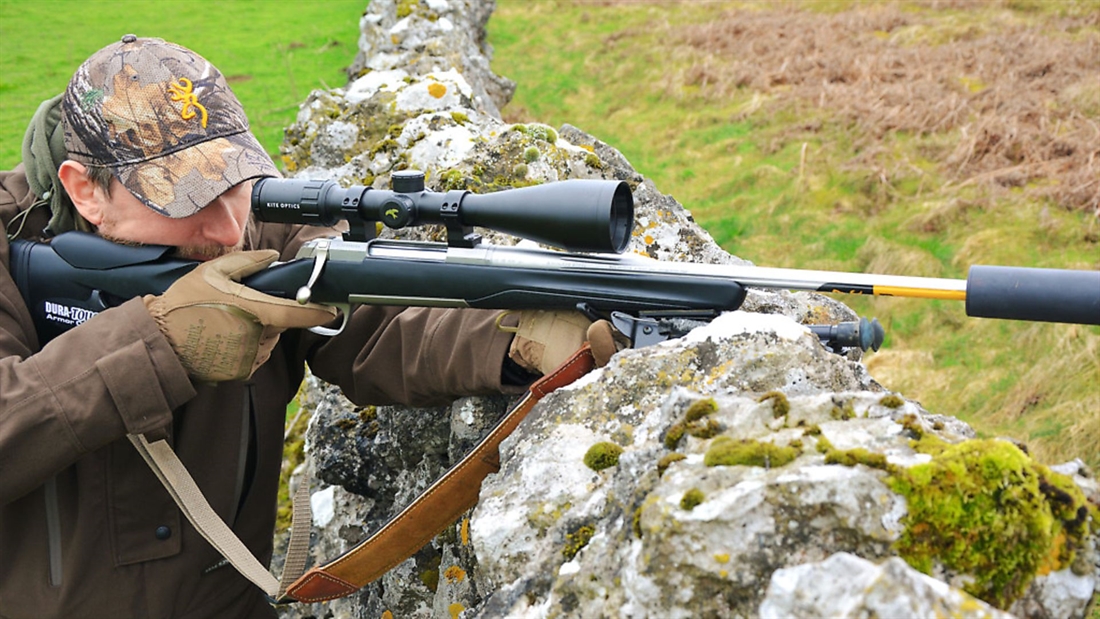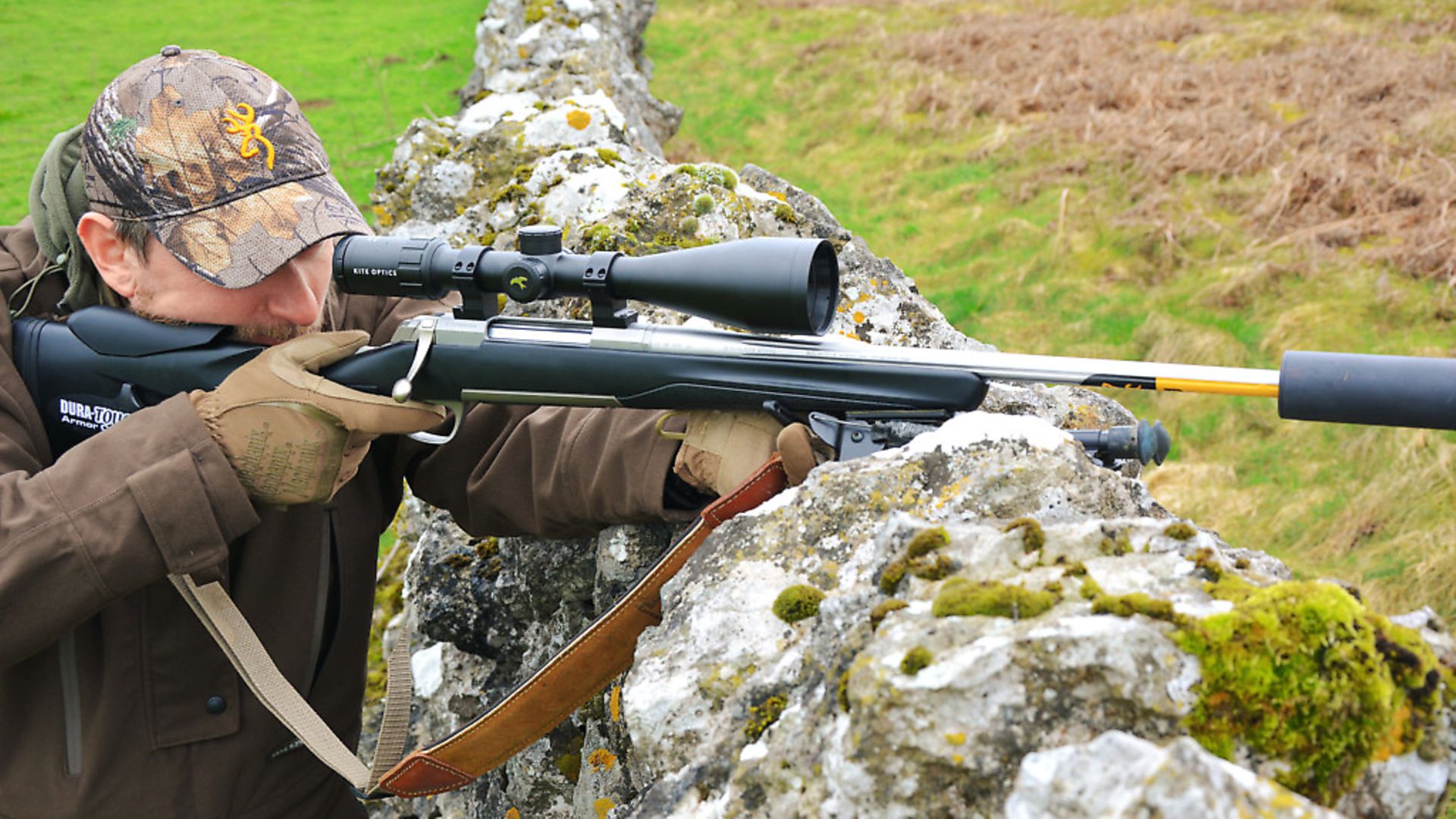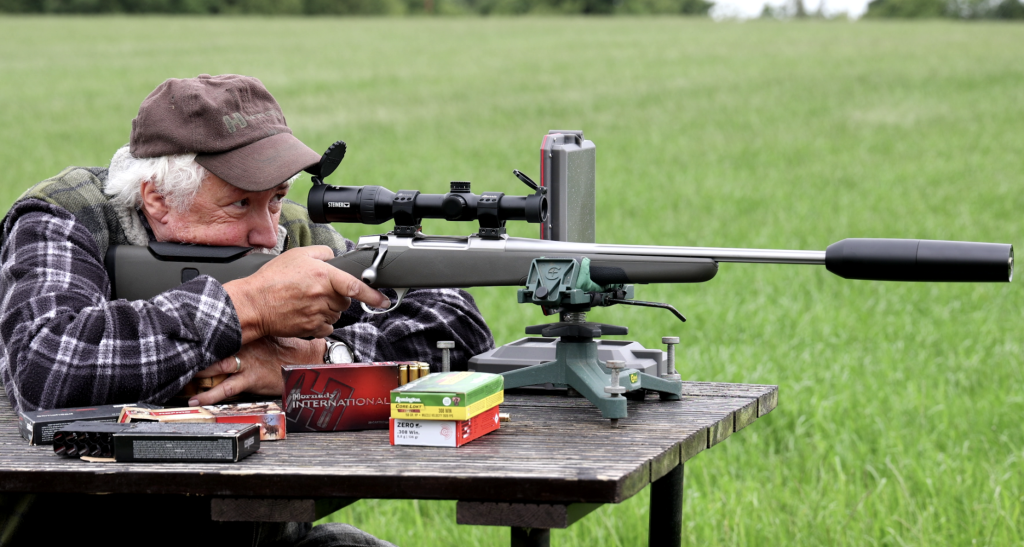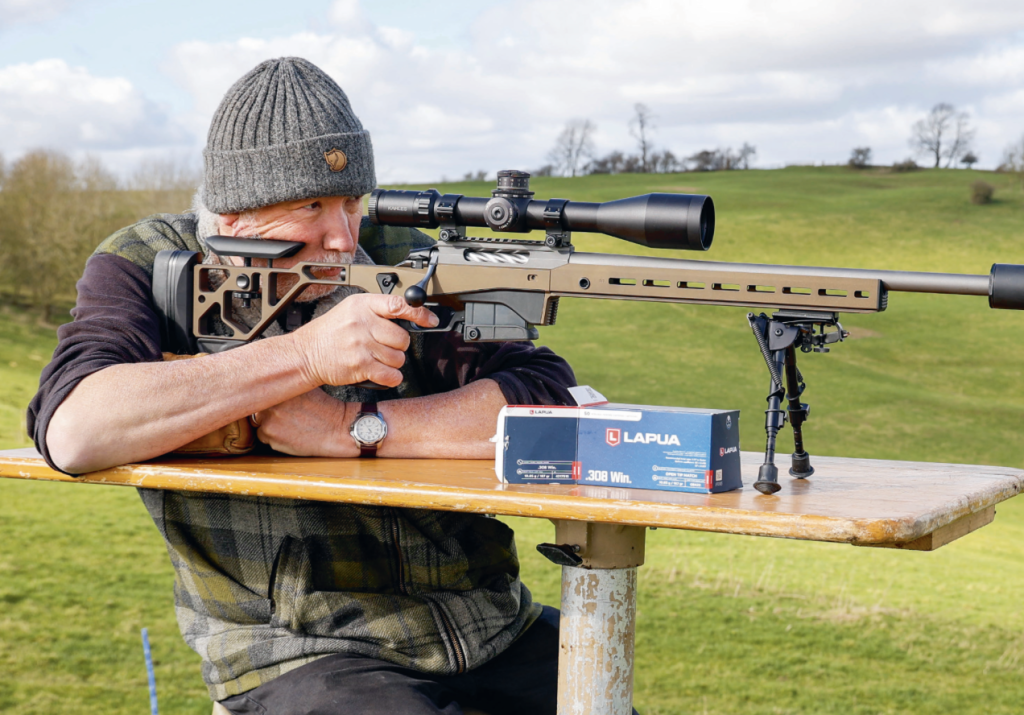In depth rifle test and review – Browning X-Bolt Synthetic Stainless Fluted in 30-06

The Browning X-Bolt Synthetic Stainless Fluted in 30-06 displays great handling, accuracy abd build quality in this test and review by Chris Parkin
Likes
* Accuracy was, without doubt, exceptional
* Hand bedded action is no doubt a huge benefit
* Great handling from optimised stock ergonomics with superb recoil control
* An ideal choice for shooters needing versatile cheekpiece, regardless of calibre
Dislikes
*Slight creep on the trigger
Verdict
*I feel short barrels expose the weak points in this rifles’ design and ergonomics, but on the other hand, a 30-06 in a short barrel with performance like this was shown to be exceptionally refined. A wide range of calibres are available with relevant uses and longer barrels on the big 300 WM.
Specifications
Model: X-Bolt SF Stainless Fluted Adjustable Threaded
Calibre: 30-06 (223,243,6.5×55,308,270,300WM also available)
Material: Stainless steel barrel, action and bolt
Overall length: 1080mm/42.5” (inc 2x 5mm spacers)
Weight: 3.84kg/7.46lbs (inc scope)
Magazine capacity: 3+1 (4+1 in 223) detachable
Trigger: single stage 1400gr pull weight
Barrel length: 510mm/20.5” with 6x 400mm flutes
Muzzle thread: 14x1mm inc invisible thread cap
Stock Material: Synthetic with Dura Touch finish
Accessories: Weaver scope bases, 2 x 5mm length of pull spacers, trigger lock and 1 year warranty
Recommended retail price:
* X-Bolt SF Stainless Fluted Adjustable Threaded £1,175
* Kite KSP HD2 2.5-15×56 Riflescope: £1,147
* X-Lock 30mm scope mounts £74
Contact:
Browning UK
01235 514550
Also used:
Winchester Extreme Point and Ballistic Silvertip ammunition
Browning UK
01235 514550
Tier-One Spartan III Sound Moderator
01924 404313
Sierra Bullets and PPU ammunition
Henry Krank & Co.
0113 256 9163
Vihtavouri powders and Lapua Cartridge Brass
Hannams Reloading
01977 681639
IN DEPTH
My first hunting trip to the USA left me with warm memories of the rifle I used – a Browning A-Bolt in 7mm-08. Browning’s X-Bolt rifle is more than just an evolution of the A-Bolt, and shows new features all of its own. Initially, the most striking feature is the scope mounting solution. The usual central twin base screws are replaced by four – one at each corner – to secure the bases over the top of the action, and they benefit from a greater depth of steel in which to anchor their threads. The gun is supplied with Weaver bases as standard, but I was also sent some of Browning’s superb X-Lock mounts that give a direct fit for a regular 30mm scope tube.
This X-Bolt stainless in .30-06 has a barrel that seems a little short for the mighty ‘ought 6’ cartridge, but my initial scepticism proved unfounded. Starting out with a diminutive 16mm diameter behind the neatly crowned and 14×1 threaded muzzle, it swells fluidly to 32mm at the reinforce, with a recoil lug between itself and the action. The six flutes run for just over 400mm of the barrel’s 520mm, and leave you wondering what recoil and velocities will feel like. The action shows a three-lug bolt with associated 60-degree lift, and a rather pleasant twist to the teardrop at the end of the bolt handle. It remains well clear of the scope’s ocular body at all times. This ‘twist’ to the handle, coupled with the smooth fluidity of the bolt’s feed, stroke and extraction of the well-mannered 06 cartridge, gives a fast reload speed. The knob is well positioned to catch the index finger as it rises quickly up and out from the trigger guard to flick it open. The single claw extractor and plunger ejector make light work of both primary and secondary extraction. With a thumb and forefinger encircling but not gripping the bolt knob, its 45-degree inclination perfectly matches the forward/down phase of the bolt’s cycle when force is required to close the gun at speed, and likewise the reverse of this to open, extract the case and cock the firing pin. Ergonomics like this are subtle but appreciably better; they are hard to notice until you have used a lot of rifles, but in a fast-fire scenario on running game you will get more shots away. When I think of how bad some guns are in comparison, I can’t help but like the Browning immensely for its class.
A new three-lever Feather trigger system gives a consistent, reliable break at 1,400g from the single stage pull. There are adjustment screws within the metallic castings of the mechanism, but these are well sealed with thread lock and do not invite modification, although a 3-5lb range is advertised. There is about 1mm of creep at the tip of the smooth, curved blade at the time of break. You can’t feel any grittiness, but you do feel the steady movement as you squeeze towards the break; although not as perfect as some, to my mind, it is certainly an easy trigger to get good results from. It strikes a good balance for weight within a slightly angular trigger guard, which will comfortably accept a gloved fingertip in cold weather. The safety catch sits on the extended tang below the cocked action indicator protruding from the bolt shroud. The bolt locks when on ‘safe’, and a small button at the root of the bolt handle, where it attaches to the shaft, allows the bolt to be opened with a thumb press that is most intuitive in feel and operation. Just don’t heave up the bolt handle without removing your thumb, as it will get squashed between the bolt handle and the underside of the scope’s ocular body, and it will hurt… I would imagine (wink wink!). The safety locks the trigger sear and blocks the firing pin.
All of the external stainless metalwork is finished to a matt sheen which wipes clean easily and doesn’t rub the skin from your hands. The bolt shaft has a mirror-like polish both visually and mechanically with similarly exquisite finish to all other internal metal components, such as the bolt shroud and handle, though there is slight colour variation on the surfaces from one to the next. Browning’s rotary magazine holds three rounds with an extra in the chamber if needed. Push feed was flawless with any style of bullet, from round nosed to ballistic tipped. The release catch is at the front of the magazine and, although the mag doesn’t spring out, the intelligent positioning of the catch itself draws the mag straight into the palm of your waiting hand. Reinserting a fresh magazine is fast with no issues such as an overly tight fit in the magazine well – it just slaps straight in as fast as an AK47! Single rounds dropped into the ejection port will also feed straight to the chamber and up the feed ramp with no snags for emergency single shots.
I was, so far, impressed, but duly cautious of forming a full opinion until I’d actually shot the gun. The .30-06 seems a lot more gentlemanly than the smaller .308, which feels snappy in most rifles, especially those with short barrels. A light 3.84kg/8.46lb overall weight warned that things might get lively, yet they didn’t, and here is why… The X-Bolt’s synthetic stock is injection moulded with extensive diagonal ribbing within the structure which allows the unit to retain mechanical rigidity, while also maintaining a light weight. It also dampens any dull harmonics and hollow reverberation when firing, or if it gets bumped against a tree branch, etc. The fore-end is slim but the finger groove enables a secure hold, allowing you to pull the gun into your shoulder when standing or for improvised shots, with the right hand remaining free for bolt and trigger duties. This barrel remains free-floating at all times, from any position too. The rubberised finish and stippled finish add further security to a relaxed but firm hold, on a gun where your fingers never seem likely to drift into contact with the barrel. Similar patterning extends to the relatively straight hand pistol grip, aiding the push and pull mounting feel of a good shotgun. The entire gun was presented and pointed towards target before being drawn back into the shoulder for correct recoil control. The Inflex recoil pad was over an inch thick in the centre and offered a 361mm/14¼” length of pull with both supplied 5mm spacers fitted. It’s soft in the centre but curved to lock into place with slightly firm, but not hard, toe and heel and a grippy rear surface. Recoil was as firm as a .30-06 normally is, but very gentle on the shoulder, with that characteristic long shove rather than a .308’s ‘snap’.
Now, soft recoil pads protect your shoulder, but do not always benefit your face. The moving gun versus stationary cheek can cause a delicate but incremental ‘concussion’ feel that is both tiring and painful, causing the head to subconsciously lift on the shot and veer away from the desired eye position for retaining optimum telescopic sighted vision, but this was not the case with the X-Bolt. An adjustable cheekpiece has been fitted, but it is not some ‘cutout’ from the stock with a huge great bulbous comb that your head rolls over; it is a slim, 2mm-thick polymer moulding showing 20mm of height adjustability which has remained slender in profile to rest under your cheekbone, rather than binding against your jawline. It will happily rise higher than is required for most men, yet is ideal for a lady, and somewhere halfway through its travel was optimum for the 56mm scope I mounted close to the barrel. Its triangular knob on the right side of the gun needs firm fingers to fully and securely tighten it, but once it’s tight it does stay in position and you don’t have to adjust it to take the bolt out, with its release catch to the left side of the action. It is also angled slightly forwards and down to further negate the perceived recoil – excellent!
Careful ergonomic design has made this gun, if a not insubstantial calibre for most shooters, perform with impeccable ‘table manners’, and for anyone with concerns over recoil I have to say that, in my opinion, this is a design to beat.
Accuracy on paper was initially acceptable using Winchester’s 150gr Extreme Point ammunition, with a consistent but not massively impressive 35-40mm average group size at 100m for three rounds. I tried the 150 Ballistic Silvertip next, in its sparkly nickel-plated cases. This coated bullet was more impressive, with groups dropping into the magic 25mm/1” circle but never seeming to cloverleaf, even though the gun felt so assured to shoot. I can’t put a statistical analysis to this result, but I have a suspicion that short barrels, especially in calibres with plenty of powder to burn, don’t get the best from factory ammunition – a possibly incomplete powder burn exacerbating factory ammunition’s volumetric powder measuring tolerances will never compete with hand-weighed charges optimised for the barrel. Speeds weren’t actually much lower than the boxes’ estimated values – the BST 150s were producing 860m/s (2,822fps) quite consistently, which is only 50fps below what they estimate on the box. However, a longer barrel would have increased this, and I was unable to clarify Winchester’s test barrel length. I once had a 32” .308 that would easily produce 26”-barrelled .300 Win Mag velocities with 150gr bullets. I know full well that efficient calibres like the .30s family will always give back what they have to work with, and to me a .30-06 is a 2,950-3,000fps calibre with 150s… but who am I to judge?
It’s a while since I hand-loaded any .30-06s, and having no particular pet recipe I went along with manual recommendations for a 165gr Sierra Gameking bullet, Vihtavuori N160 powder in the Winchester cases and a CCI BR2 primer. What ensued rather stunned me. The gun, and I kid you not, was stamping in sub half-inch cloverleaf groups with no specific tailoring, time after time. They were pretty close to a quarter of an inch! I added another grain of powder to push the velocities a little as there were no pressure signs showing, but it looks like I had struck lucky the first time around. I also tried 180gr Sierra Gamekings which, although only punching the ½ to ¾” window, also did it every time. Velocities were a little slower, with only 2,650fps/807m/s on the chronograph for the 165s, but speed never killed anything, whereas reliable accuracy and consistency did! The X-Bolt did this with all ammunition, including some Prvi Partizan.
So, I had proven this to myself as a rifle well worth my trust regardless of ammunition, as it never threw up any surprises. When I stripped the stock off, one of the key secrets to performance was undoubtedly revealed. Watching the stock’s fore-end as the front action screw was loosened showed zero movement, i.e. the barrel did not spring up and rise out of its channel by even a tenth of a millimetre. Removing the second screw and lifting the gun out showed me why: not only was the stock moulding done neatly with a perfectly symmetrical 1mm barrel gap along the entire channel’s length, but it was bedded, too. Small but critical areas around the recoil lug and footprint of the receiver were situated within smooth, if perhaps not visually perfect, areas of epoxy compound which showed hand finishing and consequent performance perfection. The fact that the gun showed such capability on target was now no surprise, as stock-to-metal fit is critical to accuracy, and failure to achieve that alone spoils many good actions and barrels. Browning promises triple-checked and air-gauged barrels which I will concur with; the borescope showed no failings in internal machining standards. Even if the gun took a good cleaning fresh from the box, further usage saw it clean up easily with minimal copper fouling. It was a little more sooty than some, perhaps purely down to the shorter tube and less pressure burn time.
This is one of the slickest externally lugged (rather than recessed) bolts I have used and shows a single polymer bearing lug on the right side of the faceted steel shaft to prevent it juddering and stalling in its transit. No matter how aggressively I forced the handle, extending 55mm from the 18mm shaft, I could not get it to jam at any stage of its 117mm stroke.
Twin sling studs fore and aft accepted standard sling swivels or Harris bipod, and for a rifle with such visually slender looks, it felt stable and assured in use. It never feels like a kid’s gun, yet the spacer system under the two screws of the Inflex recoil pad would make this gun absolutely ideal for those of smaller stature, or for those that are recoil shy. Browning supplied the latest Kite KSP HD2 2.5-15×56 scope, which complemented the gun perfectly. Its precise, fine reticle remained in sharp focus at all times and was easily positioned on target to achieve good aiming accuracy, helping to achieve the small groups.
I used the gun with a Tier-One moderator fitted, and although recoil is a little more without it, it still never bothered me, and the lack of muzzle lift and steadiness of my head allowed me to get back on target faster for follow-up shots with noticeably less time required to adjust my aim. The fact that my head wasn’t being flicked up from the stock allowed me to watch bullet strike far more easily too and, regardless of calibre, this is not just an ideal gun for a regular-sized guy, it would particularly suit a smaller framed shooter; one who needs better head support, lower recoil intensity, and light weight from their rifle without sacrificing any performance.
Barrels in other calibres have been well specified as the 22” in .243 should keep it deer legal across the whole of the UK, and a 24” on the .300 Win Mag will get more appropriate performance from the recoil it will generate. Sadly, not all calibres in the X-Bolt range are available in this model, nor is the excellent left-hander, but time may change that.
Related Articles
Get the latest news delivered direct to your door
Subscribe to Rifle Shooter
Elevate your shooting experience with a subscription to Rifle Shooter magazine, the UK’s premier publication for dedicated rifle enthusiasts.
Whether you’re a seasoned shot or new to the sport, Rifle Shooter delivers expert insights, in-depth gear reviews and invaluable techniques to enhance your skills. Each bi-monthly issue brings you the latest in deer stalking, foxing, long-range shooting, and international hunting adventures, all crafted by leading experts from Britain and around the world.
By subscribing, you’ll not only save on the retail price but also gain exclusive access to £2 million Public Liability Insurance, covering recreational and professional use of shotguns, rifles, and airguns.
Don’t miss out on the opportunity to join a community of passionate shooters and stay at the forefront of rifle technology and technique.





